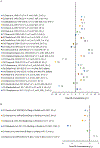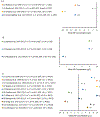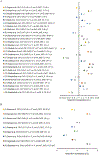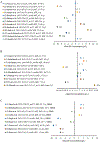Methods and analyzers for hemoglobin measurement in clinical laboratories and field settings
- PMID: 31162693
- PMCID: PMC6709845
- DOI: 10.1111/nyas.14124
Methods and analyzers for hemoglobin measurement in clinical laboratories and field settings
Abstract
This paper describes and compares methods and analyzers used to measure hemoglobin (Hb) in clinical laboratories and field settings. We conducted a literature review for methods used to measure Hb in clinical laboratories and field settings. We described methods to measure Hb and factors influencing results. Automated hematology analyzer (AHA) was reference for all Hb comparisons using evaluation criteria of ±7% set by College of American Pathologists (CAP) and Clinical Laboratory Improvement Amendments (CLIA). Capillary fingerprick blood usually produces higher Hb concentrations compared with venous blood. Individual drops produced lower concentrations than pooled capillary blood. Compared with the AHA: (1) overall cyanmethemoglobin (1.0-8.0 g/L), WHO Colour Scale (0.5-10.0 g/L), paper-based devices (5.0-7.0 g/L), HemoCue® Hb-201 (1.0-16.0 g/L) and Hb-301 (0.5-6.0 g/L), and Masimo Pronto® (0.3-14.0 g/L) overestimated concentrations; (2) Masimo Radical®-7 both under- and overestimated concentrations (0.3-104.0 g/L); and (3) other methods underestimated concentrations (2.0-16.0 g/L). Most mean concentration comparisons varied less than ±7% of the reference. Hb measurements are influenced by several analytical factors. With few exceptions, mean concentration bias was within ±7%, suggesting acceptable performance. Appropriate, high-quality methods in all settings are necessary to ensure the accuracy of Hb measurements.This paper describes and compares methods and analyzers used to measure hemoglobin (Hb) in clinical laboratories and field settings. With few exceptions, mean concentration bias was within ±7%, suggesting acceptable performance. Appropriate, high-quality methods in all settings are necessary to ensure the accuracy of Hb measurements.
Keywords: anemia; blood collection; clinical; field; hemoglobin; variability.
Published 2019. This article is a U.S. Government work and is in the public domain in the USA.
Conflict of interest statement
Competing interests
As part of their routine work duties, the authors provide technical assistance to countries in the design, training, implementation, data management, analysis, and dissemination of public health population-based surveys, including collection of Hb and anemia.
Figures





References
-
- World Health Organization (WHO). 2008. Worldwide prevalence of anemia, 1993–2005 In WHO Global Database on Anemia. de Benoist B, McLean E, Egli I & Cogswell M, Eds. Geneva: World Health Organization; Accessed October 25, 2018 http://whqlibdoc.who.int/publications/2008/9789241596657_eng.pdf?ua=1.
-
- McLean E, Cogswell M, Egli I, et al. 2009. Worldwide prevalence of anaemia, WHO Vitamin and Mineral Nutrition System, 1993–2005. Public Health Nutr. 12: 444–454. - PubMed
-
- World Health Organization (WHO). Haemoglobin concentrations for the diagnosis of anaemia and assessment of severity. World Health Organization; 2011. Accessed October 25, 2018 http://www.who.int/vmnis/indicators/haemoglobin.pdf?ua=1.
-
- Kassebaum NJ 2016. GBD 2013 Anemia Collaborators. The global burden of anemia. Hematol. Oncol. Clin. North Am. 30: 247–308. - PubMed
-
- Balarajan Y, Ramakrishnan U, Ozaltin E, et al. 2011. Anaemia in low-income and middle-income countries. Lancet 378: 2123–2135. - PubMed
Publication types
MeSH terms
Substances
Grants and funding
LinkOut - more resources
Full Text Sources
Other Literature Sources
Miscellaneous

